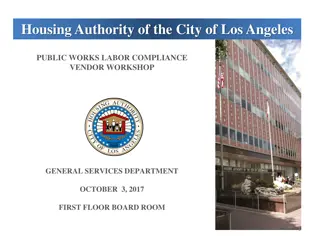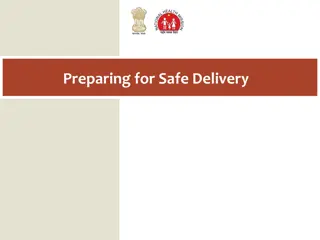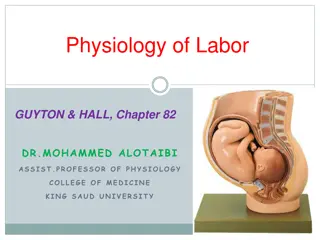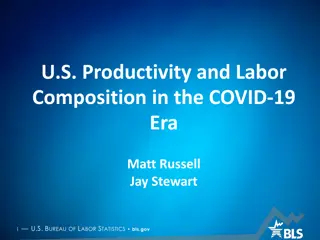Understanding Labor and Delivery: An In-depth Guide
Labor and delivery involve several stages and assessments to ensure the well-being of both the mother and the baby. From recognizing the signs of true labor to understanding the stages of labor, pain management options, and interventions such as active management of the third stage, this comprehensive guide provides essential information for healthcare professionals and expectant mothers. Learn about operative delivery, common complications, and a case study scenario to enhance your knowledge in intrapartum care.
Download Presentation

Please find below an Image/Link to download the presentation.
The content on the website is provided AS IS for your information and personal use only. It may not be sold, licensed, or shared on other websites without obtaining consent from the author. Download presentation by click this link. If you encounter any issues during the download, it is possible that the publisher has removed the file from their server.
E N D
Presentation Transcript
Intrapartum Care 433OBGYNteam@gmail.com
Labor is: 1. Painful contractions 2. Cervical dilation False labor Braxton-Hicks contractions : Contractions with no dilation When the mom present to the hospital in labor we must assess: Fetal heart tone Fetal presentation We also need to do vaginal exam to assess: Cervical dilation: Complete dilation is 10 cm Effacement: is when the length between external os and internal os is decreased Station: is the fetal presenting part in relation to ischial spine Ischial spine: 0 station Above ischial spine: -1,-2,-3,-4,-5 Below ischial spine: +1,+2,+3,+4,+5
Stages of labor: Stage 1: is the onset of labor to full cervical dilation 1. Active Phase: > 4cm dilation it can last for days 2. Latent Phase: < 4 cm dilation 1.2 1.5 cm dilation every hour Stage 2: starts from the complete dilation to time of delivery Stage 3: starts from delivering the baby to the delivery of the placenta Stage 4: is the immediate postpartum period after delivering the placenta to 2 hours later. Pain in labor: Stage 1: because of the severe abdominal contractions it is called visceral pain T10,L1 Stage 2: baby will start to be delivered the pain will be lower so is called somatic pain S2,S4 Pain control during labor: Epidural block: the most effective IV Opioids
Active management of the 3rd stage of labor: This can decrease postpartum hemorrhage It includes: 1. Fundal massage 2. Gentle cord traction 3. IV\IM Oxytocin Placenta separation usually takes up to 30 minutes. 2 signs that tell placenta is separating: 1. Gush of blood 2. Lengthening of the umbilical cord
Operative Delivery: Is used when: 1. Prolonged or arrested second stage of labor 2. Suspicion of immediate or potential fetal death 3. Shortening of the second stage for maternal benefit. Instruments used: 1. Forceps 2. Vacuum Major complications after delivery: Bleeding Infections High blood pressure Unsafe abortions Complications from delivery
CASE: A 23-year old G1P0 woman at 38 weeks gestation comes to Labor and Delivery complaining of a 5-hour history of painful contractions occurring every 5 minutes and lasting 45-60 seconds in duration. She denies leaking of fluid per vagina, but has noted bloody show. She reports normal fetal movement. In reviewing her chart, you find that she has had an uncomplicated prenatal course. She had an ultrasound at 17 weeks that revealed a male fetus and was consistent with her last menstrual period dating. A screening culture at 36 weeks was positive for group B streptococcus. The cervical exam at the 36-week visit was closed and long. Her blood pressure is 96/54, pulse 92 beats per minute, respirations are 20/minute and oral temperature is 98 F. Leopold s maneuver reveals the fetal back is palpable at the right side of the maternal abdomen and the vertex is palpable through the maternal abdomen just below her symphysis pubis. Fetal heart rate (FHR) is in the 150s with moderate variability, with accelerations and no decelerations. Contractions are noted on the external monitor every 3 minutes. The patient s cervix is 3 cm dilated, 50% effaced with the fetal vertex at 0 station. The remainder of the physical exam is unremarkable.
1. Is this patient in labor? What elements of the case history support a diagnosis of labor? True labor is defined as progressive dilation and effacement of the cervix in response to regular uterine contractions. False labor is defined as contractions at term that do not result in cervical change and are termed Braxton-Hicks contractions. 2. What is the stage and phase of labor for this patient? Stage 1: the onset of labor to full cervical dilation which is further divided into two phases: Latent phase: onset of labor to the beginning of the active phase Active phase: period of rapid cervical dilation (1-2 cm / hr); 60 percent of patients reach the latent- active phase transition by 4 cm dilation and 90 percent by 6 cm dilation Stage 2: complete dilation to delivery of the infant Stage 3: Delivery of the infant to delivery of the placenta Stage 4: Delivery of placenta to 2 hours after. The Friedman curve is falling out of favor, but is important historically. Interventions should be considered based on the specific circumstances involved in each laboring patient.
3. In addition to determining whether this patient is in labor or not, what should be included in the initial evaluation of a patient who presents in labor? Establish the gestational age through comparison of available dating criterion such as last menstrual period, sonography, and physical exam (e.g. fundal height). Identify any maternal medical or obstetrical complications of pregnancy by review of patient records and focused history and physical exam. Identify any fetal conditions by review of patient records and focused history and physical exam. Review routine screenings tests (e.g. group B streptococcus) Identify any new maternal conditions that may impact labor management (e.g. preeclampsia, chorioamnionitis). Establish fetal viability using either external ultrasound Doppler or bedside sonography. Evaluate the fetal presentation and estimated fetal weight using either Leopold s maneuvers, vaginal exam, or bedside sonography. Assess the adequacy of the maternal pelvis through physical examination (clinical pelvimetry) and review of patient s prior labor outcomes, if applicable. Assess the cervical status and membrane status.
4. What are your next steps in management of this patient? Appropriate prophylaxis (e.g. group B streptococcus) Fetal heart rate monitoring (external vs. internal and intermittent vs. continuous) Uterine contraction monitoring (external vs. internal) Serial assessment of maternal labor progress (dilation, effacement, station) Serial assessment of maternal pain status 5. What options for pain management are available for this patient? Pain Pathways: Uterine contractions and cervical dilation result in visceral pain (T-10 through L-1) Descent of the fetal head and subsequent pressure on the pelvic floor, vagina, and perineum generate somatic pain transmitted by the pudendal nerve (S2 4). Analgesia and Anesthesia options: Systemic narcotics Regional: Local anesthetic agents Pudendal block Para-cervical block Continuous lumbar epidural Prepared childbirth (e.g.Lamaze classes)
6. Describe the process by which the fetus descends through the birth canal and the steps of vaginal delivery. The fetus descends through the maternal pelvis through various flexions and rotations called the cardinal movements of labor: Engagement Descent Flexion Internal rotation Extension External rotation Expulsion What are other methods of delivery if the patient had not been able to push effectively or if fetal intolerance of labor had developed? Modes of operative delivery: Operative vaginal delivery (forceps or vacuum) Cesarean delivery Indications for operative delivery can be put into 4 categories: Maternal indications (e.g. poor expulsive effort) Fetal indications (e.g. fetal intolerance of labor, anomalies/malformations) Abnormal labor (e.g. secondary arrest of dilation in the active phase) Elective (primary or repeat Cesarean) 7.
Done by: Sara Alsiddiqi Revised by: Razan AlDhahri























